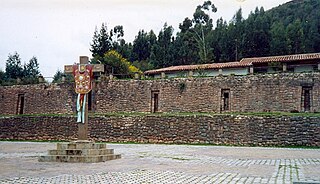
Huánuco is a department in central Peru. It is bordered by the La Libertad, San Martín, Loreto and Ucayali regions in the north, the Ucayali Region in the east, the Pasco Region in the south and the Lima and Ancash regions in the west. Its capital is the city Huánuco.

Incahuasi District or Inkawasi is one of six districts of the Ferreñafe Province in the lambayeque Region in Peru.

Macari District is one of nine districts of the Melgar Province in Peru. The capital of the district is Macari.

Cachimayo District is one of nine districts of the province Anta in Peru.

Coya District is one of eight districts of the Calca Province in the Cusco Region of Peru.

Pisac District is one of eight districts of the province Calca in Peru.

Taray District is one of eight districts of the Calca Province in the Cusco Region in Peru. Its seat is Taray. The town lies near Pisac, southwest of it, at a stream called Pawayuq (Pahuayoc), an affluent of Willkanuta River.
San Pedro District is one of eight districts of the province Canchis in Peru.

Tinta District is one of eight districts of the Canchis Province in Peru.
Pallpata District is one of eight districts of the Espinar Province in Peru.
Quelloúno is one of ten districts of the La Convención Province in the Cusco Region in Peru.
Omacha District is one of nine districts of the province Paruro in Peru.

Inka Wasi or Inkawasi is an archaeological site in Peru. It is located in the Ayacucho Region, Parinacochas Province, Pullo District.

Colcampata is an archaeological site in Peru. It is situated in the Cusco Region, Cusco Province, Cusco District.
Markapukyu is an archaeological site in Peru. It is situated in the Pasco Region, Pasco Province, Yarusyacán District, at a height of 3,787 metres (12,425 ft).

Carachupa is an archaeological site with rock art in Peru. It is located near the village of Carachupa, in Lonya Grande District, region of Amazonas.

Purunllacta or Purum Llacta (possibly from Quechua purum, purun savage, wild / wasteland, llaqta place is an archaeological site in Peru. It is situated in the Amazonas Region, Chachapoyas Province, Soloco District, southwest and near the archaeological site of Purum Llaqta of the Cheto District.

Putka is a mountain in the Paryaqaqa mountain range in the Andes of Peru, about 5,300 metres (17,388 ft) high. It is located in the Junín Region, Yauli Province, in the districts of Suitucancha and Yauli, north of Qarwachuku.
Putkaqucha is a lake in Peru located in the Junín Region, Yauli Province, Suitucancha District. It lies in the Paryaqaqa or Waruchiri mountain range, south of the mountain Putka.

Mataqucha is a mountain in the Andes of Peru, about 5,000 metres (16,404 ft) high, at a small lake of the same name. The mountain is located in the Lima Region, Cajatambo Province, Gorgor District, in the Huaura Province, Ambar District, and in the Oyón Province, Caujul District. It lies southeast of Wathiyaqucha and Puka Parya.


















